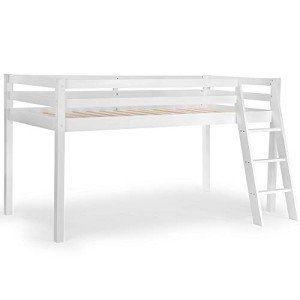Exploring Bunk Beds: A Comprehensive Guide
Bunk beds have long been a staple in children's bedrooms, dorms, and even homes with minimal space. Not just do they offer a practical sleeping solution, however they also produce an enjoyable and imaginative environment for children and a great space-saver for adults and households. This short article will check out everything you need to learn about bunk beds, from types and materials to security suggestions and purchasing suggestions.
Table of Contents
- Types of Bunk Beds
- Conventional Bunk Beds
- Loft Beds
- Triple Bunk Beds
- L-Shaped Bunk Beds
- Product Options
- Wood
- Metal
- Safety Considerations
- Purchasing Guide
- FAQs
Kinds Of Bunk Beds
Bunk beds come in various designs to suit different requirements and choices. Here's a breakdown of the most common types:
Conventional Bunk Beds
Conventional bunks generally feature 2 beds stacked vertically on top of one another. These beds are perfect for brother or sisters sharing a room or for taking full advantage of sleeping space in guest spaces.
Loft Beds
Loft beds stand similarly to traditional bunk beds however do not have a lower sleeping location. Instead, they often integrate a desk or seating area below, making them a great choice for small spaces needing multifunctionality.
Triple Bunk Beds
Triple bunk beds are designed for three occupants, with beds stacked in a three-tier configuration. These are less typical however can be a fun option for large families or pajama parties.
L-Shaped Bunk Beds
With one bed positioned horizontally and the other vertically, L-shaped bunk beds are often equipped with extra functions such as desks or storage drawers and can match corner areas in a space.
Contrast of Bunk Bed Types
| Bed Type | Suitable Use | Description |
|---|---|---|
| Traditional | Shared bedrooms or visitor spaces | Two beds stacked vertically |
| Loft | Small spaces needing multi-purpose space | Upper bed with open space underneath |
| Triple | Large households or sleepovers | 3 beds stacked vertically |
| L-Shaped | Corner or versatile spaces | A combination of vertical and horizontal beds |
Material Options
Bunk beds are produced from various materials, with wood and metal being the most typical. Each product has its benefits and drawbacks.
Wood
- Resilience: Generally robust and can stand up to years of use.
- Visual Appeal: Offers a traditional look that can blend with different decorations.
- Weight Capacity: Typically sturdier; can support heavier weights.
- Downsides: May be more costly than metal choices and can be susceptible to scratches.
Metal
- Sturdiness: Generally light-weight and easy to move but still durable.
- Modern Design: Often comes in streamlined styles, making it appealing for contemporary areas.
- Cost-efficient: Usually less costly than wooden options.
- Downsides: Can be cold to the touch in winters and may not have the same visual appeal for some buyers.
Safety Considerations
When it concerns bunk beds, safety can not be overlooked. Here are crucial security suggestions to keep in mind:
- Guardrails: Ensure that the top bunk has guardrails on both sides to prevent falls.
- Durable Construction: Check for a solid develop and strong materials to endure weight and movement.
- Weight Limit: Adhere to the maker's weight limit for both the upper and lower bunks.
- Ladder Design: Choose bunks with a safe, easy-to-climb ladder and prevent any sharp edges or rungs.
- Age Restrictions: Most producers recommend that kids under the age of 6 ought to not sleep in the upper bunk.
Buying Guide
When searching for bunk beds, think about the list below factors to discover the best fit for your needs:
- Space Availability: Measure the room size and ceiling height, ensuring there is adequate space for the top bunk.
- Bed Size: Decide between twin, full, or larger sizes based upon your requirements and the size of the room.
- Design Preference: Consider the overall decoration of the bedroom to find an appropriate style.
- Reduce of Setup: Look for a bunk bed that is uncomplicated to put together.
- Spending plan: Bunk beds come in various cost varieties, so figure out a budget before beginning your search.
FAQs
1. What is the recommended age for kids to sleep on the leading bunk?
Kids aged 6 and older are normally recommended to sleep on the leading bunk to decrease the danger of falls.
2. How can I make my bunk bed safer?
To improve security, guarantee guardrails are effectively set up and examine that the bed is put on a flat surface area. In addition, motivate kids to use the ladder thoroughly.
3. Can I transform a bunk bed into 2 different beds?
Numerous bunk beds are designed to be convertible. Check the manufacturer's requirements for convertibility features.
4. What devices are readily available for bunk beds?
Common accessories include beddings, storage drawers, staircases rather of ladders, and tented canopies for a fun visual appeal.
5. How do I keep my bunk bed?
Routine look for loose screws or structural stability can assist guarantee safety. Dust the bed routinely and tidy spills immediately to keep the products in good condition.
Bunk beds are versatile and a space-efficient solution for various living scenarios, from children's spaces to guest lodgings. With Bunk Bed For Sale and materials available, possible buyers have a wealth of options to think about, ensuring a combination of functionality and looks. By focusing on UK Bunk Beds and following the suggestions laid out in this guide, individuals can discover the ideal bunk bed that matches their space and way of life, all while creating a satisfying sleeping environment.

